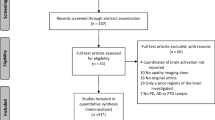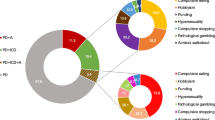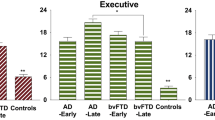Abstract
Apathy is a common but poorly understood neuropsychiatric disturbance in Parkinson’s disease (PD). In a recent study using event-related brain potentials we demonstrated impaired reward processing and compromised mesocortico-limbic pathways in PD patients with clinical symptoms of apathy. Here we aimed to further investigate the involvement of reward circuits in apathetic PD patients by assessing potential differences in brain structure. Using structural magnetic resonance imaging (MRI) and voxel-based morphometry (VBM) we quantified grey matter volume (GMV) in a sample of 18 non-demented and non-depressed PD patients with apathy, and 18 matched non-apathetic patients. Both groups were equivalent in terms of sociodemographic characteristics, disease stage, cognitive performance and L-Dopa equivalent daily dose. Apathetic patients showed significant GMV loss in cortical and subcortical brain structures. Various clusters of cortical GMV decrease were found in the parietal, lateral prefrontal cortex, and orbitofrontal cortex (OFC). The second largest cluster of GMV loss was located in the left nucleus accumbens (NAcc), a subcortical structure that is a key node of the human reward circuit. Isolated apathy in our sample is explained by the combined GMV loss in regions involved in executive functions, and cortical and subcortical structures of the mesolimbic reward pathway. The correlations observed between apathy and cognition suggests apathy as a marker of more widespread brain degeneration even in a sample of non-demented PD patients.


Similar content being viewed by others
References
Aarsland, D., Bronnick, K., Alves, G., Tysnes, O. B., Pedersen, K. F., Ehrt, U., et al. (2009). The spectrum of neuropsychiatric symptoms in patients with early untreated Parkinson's disease. Journal of Neurology, Neurosurgery, and Psychiatry, 80(8), 928–930. doi:10.1136/jnnp.2008.166959.
Aarsland, D., Muniz, G., & Matthews, F. (2011). Nonlinear decline of mini-mental state examination in Parkinson's disease. Movement Disorders, 26(2), 334–337. doi:10.1002/mds.23416.
Baggio, H. C., Segura, B., Garrido-Millan, J. L., Marti, M. J., Compta, Y., Valldeoriola, F., et al. (2015). Resting-state frontostriatal functional connectivity in Parkinson's disease-related apathy. Movement Disorders, 30(5), 671–679. doi:10.1002/mds.26137.
Bohnen, N. I., Kaufer, D. I., Hendrickson, R., Ivanco, L. S., Lopresti, B. J., Constantine, G. M., et al. (2006). Cognitive correlates of cortical cholinergic denervation in Parkinson's disease and parkinsonian dementia. Journal of Neurology, 253(2), 242–247. doi:10.1007/s00415-005-0971-0.
Bohnen, N. I., Kaufer, D. I., Hendrickson, R., Constantine, G. M., Mathis, C. A., & Moore, R. Y. (2007). Cortical cholinergic denervation is associated with depressive symptoms in Parkinson's disease and parkinsonian dementia. Journal of Neurology, Neurosurgery, and Psychiatry, 78(6), 641–643. doi:10.1136/jnnp.2006.100073.
Carriere, N., Besson, P., Dujardin, K., Duhamel, A., Defebvre, L., Delmaire, C., et al. (2014). Apathy in Parkinson's disease is associated with nucleus accumbens atrophy: a magnetic resonance imaging shape analysis. Movement Disorders, 29(7), 897–903. doi:10.1002/mds.25904.
Daniel, S. E., & Lees, A. J. (1993). Parkinson's Disease Society Brain Bank, London: overview and research. Journal of Neural Transmission. Supplementum, 39, 165–172.
Drevets, W. C. (2007). Orbitofrontal cortex function and structure in depression. Annals of the New York Academy of Sciences, 1121, 499–527. doi:10.1196/annals.1401.029.
Dubois, B., Burn, D., Goetz, C., Aarsland, D., Brown, R. G., Broe, G. A., et al. (2007). Diagnostic procedures for Parkinson's disease dementia: recommendations from the movement disorder society task force. Movement Disorders, 22(16), 2314–2324. doi:10.1002/mds.21844.
Dujardin, K., Sockeel, P., Devos, D., Delliaux, M., Krystkowiak, P., Destee, A., et al. (2007). Characteristics of apathy in Parkinson's disease. Movement Disorders, 22(6), 778–784. doi:10.1002/mds.21316.
Emre, M., Aarsland, D., Brown, R., Burn, D. J., Duyckaerts, C., Mizuno, Y., et al. (2007). Clinical diagnostic criteria for dementia associated with Parkinson's disease. Movement Disorders, 22(12), 1689–1707 quiz 1837. doi:10.1002/mds.21507.
Folstein, M. F., Folstein, S. E., & McHugh, P. R. (1975). “Mini-mental state”. A practical method for grading the cognitive state of patients for the clinician. Journal of Psychiatric Research, 12(3), 189–198.
Goetz, C. G., Tilley, B. C., Shaftman, S. R., Stebbins, G. T., Fahn, S., Martinez-Martin, P., et al. (2008). Movement Disorder Society-sponsored revision of the unified Parkinson's disease rating scale (MDS-UPDRS): scale presentation and clinimetric testing results. Movement Disorders, 23(15), 2129–2170. doi:10.1002/mds.22340.
Gotham, A. M., Brown, R. G., & Marsden, C. D. (1986). Levodopa treatment may benefit or impair “frontal” function in Parkinson's disease. Lancet, 2(8513), 970–971.
Gotham, A. M., Brown, R. G., & Marsden, C. D. (1988). 'Frontal' cognitive function in patients with Parkinson's disease 'on' and 'off' levodopa. Brain, 111(Pt 2), 299–321.
Hoehn, M. M., & Yahr, M. D. (1967). Parkinsonism: onset, progression and mortality. Neurology, 17(5), 427–442.
Isella, V., Melzi, P., Grimaldi, M., Iurlaro, S., Piolti, R., Ferrarese, C., et al. (2002). Clinical, neuropsychological, and morphometric correlates of apathy in Parkinson's disease. Movement Disorders, 17(2), 366–371.
Jenkins, L. M., Andrewes, D. G., Nicholas, C. L., Drummond, K. J., Moffat, B. A., Phal, P., et al. (2014). Social cognition in patients following surgery to the prefrontal cortex. Psychiatry Research, 224(3), 192–203. doi:10.1016/j.pscychresns.2014.08.007.
Leentjens, A. F., Dujardin, K., Marsh, L., Martinez-Martin, P., Richard, I. H., Starkstein, S. E., et al. (2008). Apathy and anhedonia rating scales in Parkinson's disease: critique and recommendations. Movement Disorders, 23(14), 2004–2014. doi:10.1002/mds.22229.
Levy, R., & Czernecki, V. (2006). Apathy and the basal ganglia. Journal of Neurology, 253(Suppl 7), VII54–VII61. doi:10.1007/s00415-006-7012-5.
Levy, R., & Dubois, B. (2006). Apathy and the functional anatomy of the prefrontal cortex-basal ganglia circuits. Cerebral Cortex, 16(7), 916–928. doi:10.1093/cercor/bhj043.
Lieberman, M. D., & Cunningham, W. A. (2009). Type I and Type II error concerns in fMRI research: re-balancing the scale. Social Cognitive and Affective Neuroscience, 4(4), 423–428. doi:10.1093/scan/nsp052.
Litvan, I., Aarsland, D., Adler, C. H., Goldman, J. G., Kulisevsky, J., Mollenhauer, B., et al. (2011). MDS task force on mild cognitive impairment in Parkinson's disease: critical review of PD-MCI. Movement Disorders, 26(10), 1814–1824. doi:10.1002/mds.23823.
Llebaria, G., Pagonabarraga, J., Kulisevsky, J., Garcia-Sanchez, C., Pascual-Sedano, B., Gironell, A., et al. (2008). Cut-off score of the Mattis dementia rating scale for screening dementia in Parkinson's disease. Movement Disorders, 23(11), 1546–1550. doi:10.1002/mds.22173.
Marin, R. S. (1991). Apathy: a neuropsychiatric syndrome. The Journal of Neuropsychiatry and Clinical Neurosciences, 3(3), 243–254.
Martinez-Corral, M., Pagonabarraga, J., Llebaria, G., Pascual-Sedano, B., Garcia-Sanchez, C., Gironell, A., et al. (2010). Facial emotion recognition impairment in patients with Parkinson's disease and isolated apathy. Parkinsons Disease, 2010, 930627. doi:10.4061/2010/930627.
Martinez-Horta, S., Pagonabarraga, J., Fernandez de Bobadilla, R., Garcia-Sanchez, C., & Kulisevsky, J. (2013). Apathy in Parkinson's disease: more than just executive dysfunction. Journal of the International Neuropsychological Society, 19(5), 571–582. doi:10.1017/S1355617713000131.
Martinez-Horta, S., Riba, J., de Bobadilla, R. F., Pagonabarraga, J., Pascual-Sedano, B., Antonijoan, R. M., et al. (2014). Apathy in Parkinson's disease: neurophysiological evidence of impaired incentive processing. The Journal of Neuroscience, 34(17), 5918–5926. doi:10.1523/JNEUROSCI.0251-14.2014.
Milad, M. R., & Rauch, S. L. (2007). The role of the orbitofrontal cortex in anxiety disorders. Annals of the New York Academy of Sciences, 1121, 546–561. doi:10.1196/annals.1401.006.
Mumford, D. B. (1991). Hospital anxiety and depression scale. The British Journal of Psychiatry, 159, 729.
Pagonabarraga, J., Kulisevsky, J., Strafella, A. P., & Krack, P. (2015). Apathy in Parkinson's disease: clinical features, neural substrates, diagnosis, and treatment. Lancet Neurology, 14(5), 518–531. doi:10.1016/S1474-4422(15)00019-8.
Pedersen, K. F., Alves, G., Bronnick, K., Aarsland, D., Tysnes, O. B., & Larsen, J. P. (2010). Apathy in drug-naive patients with incident Parkinson's disease: the Norwegian ParkWest study. Journal of Neurology, 257(2), 217–223. doi:10.1007/s00415-009-5297-x.
Pluck, G. C., & Brown, R. G. (2002). Apathy in Parkinson's disease. Journal of Neurology, Neurosurgery, and Psychiatry, 73(6), 636–642.
Reijnders, J. S., Scholtissen, B., Weber, W. E., Aalten, P., Verhey, F. R., & Leentjens, A. F. (2010). Neuroanatomical correlates of apathy in Parkinson's disease: A magnetic resonance imaging study using voxel-based morphometry. Movement Disorders, 25(14), 2318–2325. doi:10.1002/mds.23268.
Remy, P., Doder, M., Lees, A., Turjanski, N., & Brooks, D. (2005). Depression in Parkinson's disease: loss of dopamine and noradrenaline innervation in the limbic system. Brain, 128(Pt 6), 1314–1322. doi:10.1093/brain/awh445.
Riba, J., Kramer, U. M., Heldmann, M., Richter, S., & Munte, T. F. (2008). Dopamine agonist increases risk taking but blunts reward-related brain activity. PloS One, 3(6), e2479. doi:10.1371/journal.pone.0002479.
Robert, P., Onyike, C. U., Leentjens, A. F., Dujardin, K., Aalten, P., Starkstein, S., et al. (2009). Proposed diagnostic criteria for apathy in Alzheimer's disease and other neuropsychiatric disorders. European Psychiatry, 24(2), 98–104. doi:10.1016/j.eurpsy.2008.09.001.
Robert, G. H., Le Jeune, F., Lozachmeur, C., Drapier, S., Dondaine, T., Peron, J., et al. (2014). Preoperative factors of apathy in subthalamic stimulated Parkinson disease: a PET study. Neurology, 83(18), 1620–1626. doi:10.1212/WNL.0000000000000941.
Rowe, J. B., Hughes, L., Ghosh, B. C., Eckstein, D., Williams-Gray, C. H., Fallon, S., et al. (2008). Parkinson's disease and dopaminergic therapy--differential effects on movement, reward and cognition. Brain, 131(Pt 8), 2094–2105. doi:10.1093/brain/awn112.
Santangelo, G., Vitale, C., Trojano, L., Picillo, M., Moccia, M., Pisano, G., et al. (2015). Relationship between apathy and cognitive dysfunctions in de novo untreated Parkinson's disease: a prospective longitudinal study. European Journal of Neurology, 22(2), 253–260. doi:10.1111/ene.12467.
Thobois, S., Ardouin, C., Lhommee, E., Klinger, H., Lagrange, C., Xie, J., et al. (2010). Non-motor dopamine withdrawal syndrome after surgery for Parkinson's disease: predictors and underlying mesolimbic denervation. Brain, 133(Pt 4), 1111–1127. doi:10.1093/brain/awq032.
Timbie, C., & Barbas, H. (2015). Pathways for Emotions: Specializations in the Amygdalar, Mediodorsal Thalamic, and Posterior Orbitofrontal Network. The Journal of Neuroscience, 35(34), 11976–11987. doi:10.1523/JNEUROSCI.2157-15.2015.
Tomlinson, C. L., Stowe, R., Patel, S., Rick, C., Gray, R., & Clarke, C. E. (2010). Systematic review of levodopa dose equivalency reporting in Parkinson's disease. Movement Disorders, 25(15), 2649–2653. doi:10.1002/mds.23429.
van der Vegt, J. P., Hulme, O. J., Zittel, S., Madsen, K. H., Weiss, M. M., Buhmann, C., et al. (2013). Attenuated neural response to gamble outcomes in drug-naive patients with Parkinson's disease. Brain, 136(Pt 4), 1192–1203. doi:10.1093/brain/awt027.
Weintraut, R., Karadi, K., Lucza, T., Kovacs, M., Makkos, A., Janszky, J., et al. (2016). Lille apathy rating scale and MDS-UPDRS for screening apathy in Parkinson's disease. Journal of Parasitic Diseases, 6(1), 257–265. doi:10.3233/JPD-150726.
Williams-Gray, C. H., Evans, J. R., Goris, A., Foltynie, T., Ban, M., Robbins, T. W., et al. (2009). The distinct cognitive syndromes of Parkinson's disease: 5 year follow-up of the CamPaIGN cohort. Brain, 132(Pt 11), 2958–2969. doi:10.1093/brain/awp245.
Worsley, K. J., Marrett, S., Neelin, P., Vandal, A. C., Friston, K. J., & Evans, A. C. (1996). A unified statistical approach for determining significant signals in images of cerebral activation. Human Brain Mapping, 4(1), 58–73. doi:10.1002/(SICI)1097-0193(1996)4:1<58::AID-HBM4>3.0.CO;2-O10.1002/(SICI)1097-0193(1996)4:1 < 58::AID-HBM4 > 3.0.CO;2-O.
Acknowledgments
The work of Frederic Sampedro is supported by a Spanish Government FPU doctoral grant.
Author information
Authors and Affiliations
Corresponding author
Ethics declarations
Financial disclosures
Saul Martinez-Horta, Frederic Sampedro, Ramon Fernandez-Bobadilla and Juan Marin-Lahoz declare that they have no conflict of interest.
Javier Pagonabarraga: Has received honoraria for lecturing or consultation from Boehringer Ingelheim, UCB, Allergan, Ipsen, and Lundbeck.
Jaime Kulisevsky: Has received honoraria for lecturing or consultation from the Michael J Fox Foundation, Merck Serono, AbbVie, Boehringer Ingelheim, UCB, Zambon, MSD, Italfarmaco, General Electric, and Lundbeck.
Informed consent
All procedures followed were in accordance with the ethical standards of the responsible committee on human experimentation (institutional and national) and with the Helsinki Declaration of 1975, and the applicable revisions at the time of the investigation. Informed consent was obtained from all patients for being included in the study.
Conflict of interest
All the authors report no conflict of interest.
Funding sources
This study was partially funded by public research grants from CIBERNED (Fundación CIEN, Instituto de Salud Carlos III, Spain). The work of Frederic Sampedro is supported by a Spanish Government FPU doctoral grant.
Additional information
Saul Martinez-Horta and Frederic Sampedro are contributed equally to this work
Rights and permissions
About this article
Cite this article
Martinez-Horta, S., Sampedro, F., Pagonabarraga, J. et al. Non-demented Parkinson’s disease patients with apathy show decreased grey matter volume in key executive and reward-related nodes. Brain Imaging and Behavior 11, 1334–1342 (2017). https://doi.org/10.1007/s11682-016-9607-5
Published:
Issue Date:
DOI: https://doi.org/10.1007/s11682-016-9607-5




